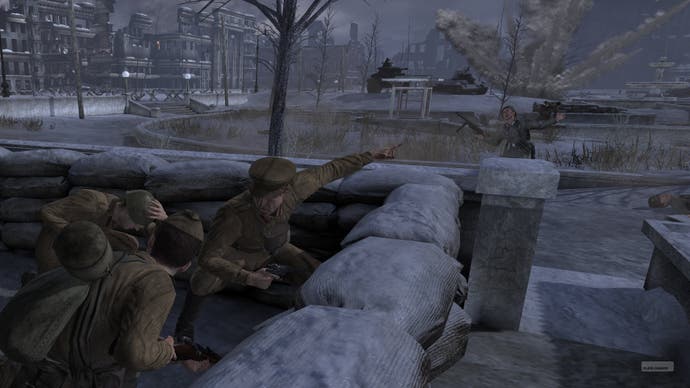Red Orchestra 2: Heroes of Stalingrad
Instruments of war.
Cover is another vital part to Heroes of Stalingrad, but isn't a digital on/off safety system; Red Orchestra 2 very much muddies the waters between just what's crouching out of view and what's squatting in great peril.
When you're wedged behind cover it's as if you've got your cheek up against a broken wall in real-life – you can see the square root of bugger all. Only tiny peeks around the edge of the cover are possible, and blindfire involves genuinely raising your gun above your head and blasting at the unknown.
Suppression, meanwhile, occurs away from cover, when bullets are being sprayed around your legs. It's the game's reference to how almost being shot dead in real-life is actually a rather fraught experience.
You'll hear your heart pumping, your increased breathing will make it hard to level your sights at targets, the edges of your screen will desaturate, recoil will become more of an issue – in short, you'll end up pulling a battlefield whitey. This can only be rectified by a spot of cowering, or of course an ally taking out your persecutor.

And what would a Red Orchestra game be if you didn't find yourself in the belly of a steel beast at some point? Tripwire's team spends three months on each and every tank to ensure its veracity, and each one has over ten different internal mechanical organs for enemies to attempt to damage. (Not to mention the fleshy humans inside.)
Within these machines (the T34 and the Panzer 4 are featured in the game's initial release), it's genuinely claustrophobic. To look out you must either click on a tiny window so you can manoeuvre yourself over and peer out, or control the Commander – the character with the sole ability to pop his head up through the roof of his little tank and have a squiz at the surroundings.
The other roles in the sweaty funk beneath him are the Driver and the Gunners, either possessed by the control of fellow players or perhaps by AI – in which case you can leap between their brains at will. Unless, of course, one of them's dead.

Should a comrade take a hit through an armour breach then their position in the tank will become empty: you'll have to swing your way through the innards of the tank if you need to man their controls. Hardly an enviable situation when you're the lone survivor of enemy shelling, then, and the recent strikes they've dialled into their turret have become ever-more precise.
All this is wrapped up, if playing the long-game, in a tiled multiplayer campaign map. Here both factions' players vote to attack or defend different the different territories of the game. This can take between four to six hours to complete, although Tripwire advise that the owner of the server could tweak it so it lasts a month.
Within that again there are Commanders with access to maps of the area who can call in artillery, aerial recon and rockets – and then disseminate information to the Squad Leaders out in the field. After a realistic period, they will in turn automatically dripfeed that information to the troops they lead.
Red Orchestra is a serious, bloody business, and it's exactly the sort of specialist and PC-dedicated shooter that the platform has been aching for. Tripwire was once a hero of the mod community, and Heroes of Stalingrad still has the delightful tang of the era when mod-teams would routinely blind-side you with dazzling new gameplay concepts and rule-sets. It's a proper PC shooter, then, with a proper PC shooter mentality. This, as Jarvis once wailed, is hardcore.


.png?width=291&height=164&fit=crop&quality=80&format=jpg&auto=webp)




.jpg?width=291&height=164&fit=crop&quality=80&format=jpg&auto=webp)
